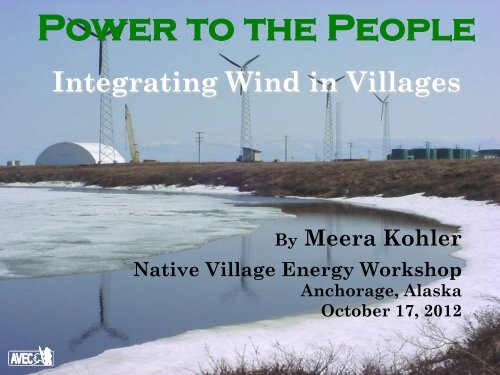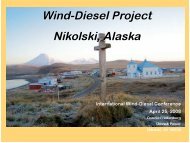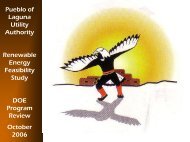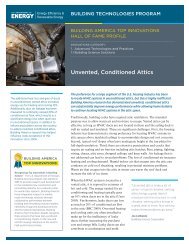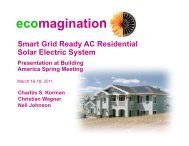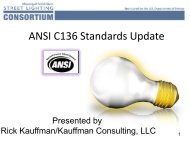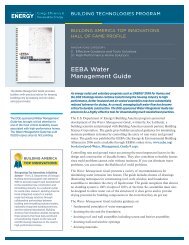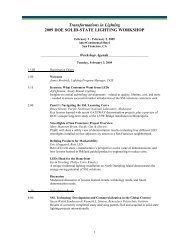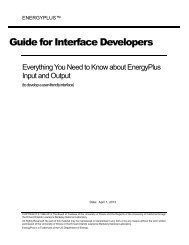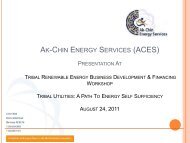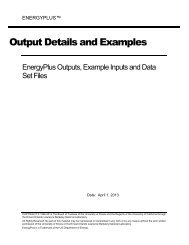Case Studies - Renewable Energy Integration: Power to the ... - EERE
Case Studies - Renewable Energy Integration: Power to the ... - EERE
Case Studies - Renewable Energy Integration: Power to the ... - EERE
Create successful ePaper yourself
Turn your PDF publications into a flip-book with our unique Google optimized e-Paper software.
<strong>Power</strong> <strong>to</strong> <strong>the</strong> People<br />
Integrating Wind in Villages<br />
By Meera Kohler<br />
Native Village <strong>Energy</strong> Workshop<br />
Anchorage, Alaska<br />
Oc<strong>to</strong>ber 17, 2012
AVEC is a non-profit member-<br />
• 55 villages<br />
owned cooperative<br />
• Formed in 1968<br />
• 7 member Board<br />
• 23,000 Population<br />
• Anvik - 86<br />
• Hooper Bay – 1,124
SYSTEM INFORMATION<br />
¢ 80 Anchoragebased<br />
Employees<br />
¢ 7,800 services<br />
¢ 50 power plants<br />
Gambell Cousins<br />
¢ 165 + diesel<br />
genera<strong>to</strong>rs<br />
¢ 95 Village<br />
technicians<br />
¢ 530 + fuel tanks<br />
¢ Over 5 million<br />
gallons fuel burned<br />
¢ 11 wind systems<br />
serving 15 villages<br />
34 turbines <strong>to</strong>tal
Alaska Vs. Lower Forty Eight
AVEC’S DELIVERED FUEL COST<br />
• Average 2002 1.29<br />
• Average 2003 1.47<br />
• Average 2004 1.98<br />
• Average 2005 2.26<br />
• Average 2006 2.26<br />
• Average 2007 2.93<br />
• Average 2008 4.55<br />
• Average 2009 3.02<br />
• Average 2010 3.30<br />
• Average 2011 4.27<br />
• Average 2012 4.02<br />
Increase 2002 - 2012 $2.73 +312%
AVEC BOARD 2018 GOALS<br />
¢Lower diesel use 25%<br />
1,250,000 gallons<br />
77% of our fuel is used in Wind Class 4+ villages<br />
¢Reduce power plants by 50%<br />
Interconnect ano<strong>the</strong>r 24 villages<br />
Wind is 6% of generation capacity<br />
5% of 2011 generation<br />
¢Reduce non-fuel costs by 10%<br />
Plant costs, depreciation, interest…<br />
Reduced rates 2 cents/kWh
What is AVEC Doing?<br />
Installing wind generation<br />
– Selawik, Toksook Bay, Kasigluk, Gambell, Savoonga,<br />
Hooper Bay, New Stuyahok, Emmonak, Quinhagak,<br />
Chevak, Mekoryuk, Shak<strong>to</strong>olik…<br />
Capturing recovered heat where feasible<br />
– More than 40 AVEC locations<br />
Building Interties<br />
– Toksook Bay <strong>to</strong> Tununak<br />
– Toksook Bay <strong>to</strong> Nightmute<br />
– Brevig Mission <strong>to</strong> Teller<br />
– Developing HVDC concept<br />
Welcoming new villages<br />
– Nightmute (1998), Teller (2005), Kotlik (2007),<br />
Ekwok (2011) Kobuk (2012)
Interconnecting Villages<br />
Reduce <strong>the</strong> number of power plants<br />
Larger loads make renewables like wind feasible<br />
Existing Interties<br />
ØKasigluk-Nunapitchuk<br />
ØSt. Mary’s-Andreafsky<br />
ØUpper Kalskag-Lower Kalskag<br />
ØSt. Mary’s-Pitka’s Point<br />
ØShungnak-Kobuk<br />
ØToksook Bay-Tununak<br />
ØToksook Bay-Nightmute<br />
ØEmmonak - Alakanuk
Future Interties<br />
Ø St. Michael’s-Stebbins - Underway<br />
Ø Brevig Mission-Teller - Underway<br />
Ø St. Mary’s-Mt. Village<br />
Ø St. Mary’s-Pilot Station<br />
Ø New Stuyahok-Ekwok<br />
Ø Togiak-Twin Hills<br />
Ø Noorvik – Kiana – Selawik (NKS)<br />
Ø Ambler – Shungnak – Kobuk (ASK)<br />
Ø Upper Kobuk – Lower Kobuk (ASK – NKS)
AVEC Wind Projects<br />
2003 Selawik<br />
2006 Kasigluk – with a tie line <strong>to</strong><br />
Nunapitchuk<br />
2006 Toksook Bay - with tie lines<br />
<strong>to</strong> Tununak and Nightmute<br />
2008 Hooper Bay and Savoonga<br />
2009 Gambell<br />
2009 Mekoryuk and Chevak<br />
erected, commissioned in<br />
2010<br />
2010 Quinhagak<br />
2010 Toksook - one more turbine<br />
2011 Emmonak/Alakanuk and<br />
Shak<strong>to</strong>olik<br />
Kasigluk
Benefits of<br />
Integrating<br />
Wind<br />
Generation<br />
• A hedge against rising fuel<br />
costs<br />
• Lower carbon footprint<br />
• Reduced exposure <strong>to</strong> oil<br />
spills<br />
• Reduced oil s<strong>to</strong>rage needs
The State and federal governments funded<br />
over 100 wind projects in Alaska in <strong>the</strong> 1980s
Nearly all failed. Lack of maintenance and<br />
poor sites were fac<strong>to</strong>rs.
Harnessing <strong>the</strong> Wind<br />
• 34 of AVEC’s 55 villages are in class 4+ wind<br />
regimes<br />
• A high-efficiency diesel genera<strong>to</strong>r yields 14<br />
kWh/gallon<br />
• A 100-kW turbine could produce 220,000 kWh/<br />
yr = 16,000 gallons displaced<br />
• Four units (a wind plot) = 64,000 gallons<br />
displaced
Many of<br />
AVEC’s<br />
villages are in<br />
Western<br />
Alaska have<br />
Class 4 or<br />
better wind<br />
regimes.<br />
Alaska Wind Resource Map
Current<br />
locations<br />
and sizes<br />
of wind<br />
farms
CURRENT CHALLENGES TO<br />
INFRASTRUCTURE DEVELOPMENT<br />
¢ Low temperatures and<br />
icing<br />
Continued…<br />
¢ Limited turbine options<br />
for remote villages<br />
¢ Winter construction is<br />
sometimes needed
Geotechnical Conditions<br />
Soils present unique<br />
challenges:<br />
• High variability<br />
• Lack of stability<br />
• Climate change impacts
CURRENT CHALLENGES TO<br />
INFRASTRUCTURE DEVELOPMENT<br />
¢ Complex logistics<br />
¢ Complex<br />
foundations<br />
¢ Turbulence<br />
Continued…
CURRENT CHALLENGES TO<br />
INFRASTRUCTURE DEVELOPMENT<br />
¢ Remote locations<br />
¢ Poor soils<br />
¢ Difficult<br />
environmental<br />
conditions
Transportation Issues
Hauling equipment between villages
And here’s <strong>the</strong> power pole!
Boardwalks are a challenge
Heavy equipment must be brought in
Roads, water and sewer lines,<br />
boardwalks and existing overhead power<br />
and phone lines present hurdles
CURRENT CHALLENGES TO<br />
INFRASTRUCTURE DEVELOPMENT<br />
Special equipment may<br />
be needed <strong>to</strong> install <strong>the</strong><br />
foundation or pilings.<br />
Special equipment, shown here,<br />
was required <strong>to</strong> twist <strong>the</strong> helical<br />
piles in<strong>to</strong> <strong>the</strong> ground in Kasigluk.
Foundations<br />
in permafrost<br />
are a major<br />
hurdle<br />
Warming trends are<br />
affecting <strong>the</strong> expanse<br />
and depth of permafrost
Foundation Design Criteria<br />
Turbines rotate a<strong>to</strong>p 100 (+) foot <strong>to</strong>wers and can<br />
cause a detrimental harmonic vibration in <strong>the</strong><br />
<strong>to</strong>wer and foundation if not designed correctly.
Foundations in<br />
Permafrost<br />
• They must not<br />
se,le, /lt or be<br />
upli4ed<br />
• Pile founda/ons<br />
(six <strong>to</strong> eight piles)<br />
may extend 1/3 <strong>to</strong><br />
2/3 <strong>the</strong> height of<br />
<strong>the</strong> <strong>to</strong>wer in<strong>to</strong> <strong>the</strong><br />
ground
Solutions <strong>to</strong><br />
Challenges:<br />
Dove-tailing<br />
AVEC projects<br />
with o<strong>the</strong>r local<br />
projects help<br />
reduce<br />
construction<br />
costs<br />
Solutions Continued…
Consolidating communities makes it feasible <strong>to</strong> integrate wind.<br />
Four turbines in Toksook Bay serve Tununak and Nightmute<br />
Toksook Bay, Alaska<br />
Solutions Continued…
Wind Assessment<br />
is critical<br />
• Determining<br />
estimated output<br />
of a project<br />
• Avoiding<br />
misplacement of a<br />
project<br />
• Identifying<br />
potential problems
Potential Problems…<br />
• Land ownership and land use in <strong>the</strong> area<br />
• Geotechnical issues for foundations<br />
• His<strong>to</strong>rical and cultural resource impacts<br />
• Bird issues<br />
• Equipment accessibility<br />
• Proximity <strong>to</strong> power lines
Wind Technicians Are Being Trained in<br />
AVEC Villages Across Alaska
AVEC and its<br />
contrac<strong>to</strong>rs are<br />
building local<br />
capacity by training<br />
wind technicians who<br />
live in <strong>the</strong> villages.<br />
These trainees<br />
have worked in<br />
<strong>the</strong> construction<br />
and operation of<br />
<strong>the</strong> new systems
TRAINING<br />
SEVERAL WIND<br />
TECHNICIANS<br />
KASIGLUK<br />
MARCH 2010
• Stuart Kingeekuk,<br />
Savoonga<br />
Left <strong>to</strong> right:<br />
Charles Green, Toksook Bay<br />
Elias Friday, Chevak<br />
Lawrence Lake, Hooper Bay
Some of <strong>the</strong> equipment is<br />
complex
Wind Technicians Lawrence Lake and<br />
Julius Bell standing by a nacelle in<br />
Hooper Bay
Wind<br />
Technician<br />
Julius Bell<br />
adjusting <strong>the</strong><br />
ro<strong>to</strong>r assembly<br />
during <strong>the</strong><br />
installation of<br />
<strong>the</strong> NW100 wind<br />
turbines in<br />
Hooper Bay,<br />
Alaska
VIEW FROM THE TOP
THE WORK AND RESULTS ARE<br />
REWARDING
Future Plans<br />
• Meteorological <strong>to</strong>wers are<br />
collecting information in<br />
several locations<br />
• We are pursuing funding for<br />
projects and interties<br />
• We are championing <strong>the</strong> All<br />
Alaska <strong>Energy</strong> Project
What Alaskans Spend on <strong>Energy</strong><br />
From 2010 Alaska <strong>Power</strong> Statistics:<br />
Electricity revenue $924 mm<br />
Gas revenue – Southcentral $536 mm<br />
Diesel – Fairbanks area 250 mm gallons<br />
Diesel – Kodiak, Copper Valley, SE 68 mm gallons<br />
Diesel – Rest of state 63 mm gallons<br />
TOTAL 381 mm gallons<br />
Diesel value at $4.00/gallon $1,524 mm<br />
Annual cost of electricity/heat $2,984 mm<br />
Expenditure in 20 years $59.7 billion
Wales, Alaska<br />
Questions?<br />
Meera Kohler<br />
Alaska Village Electric Cooperative


